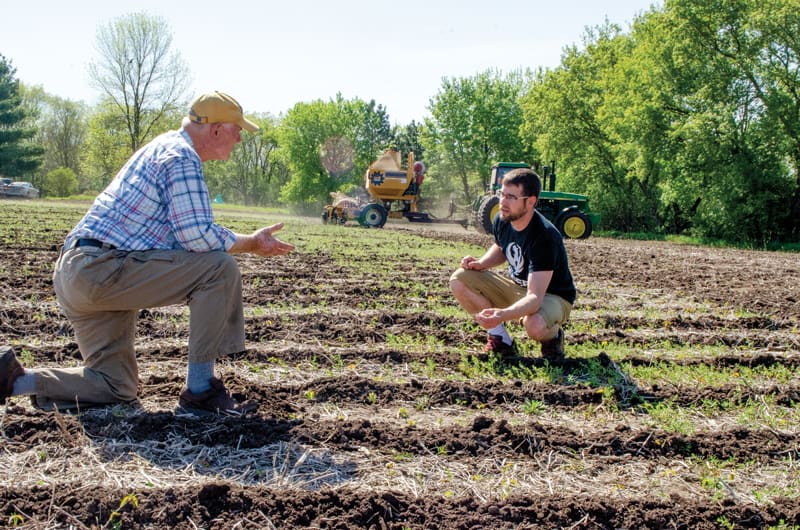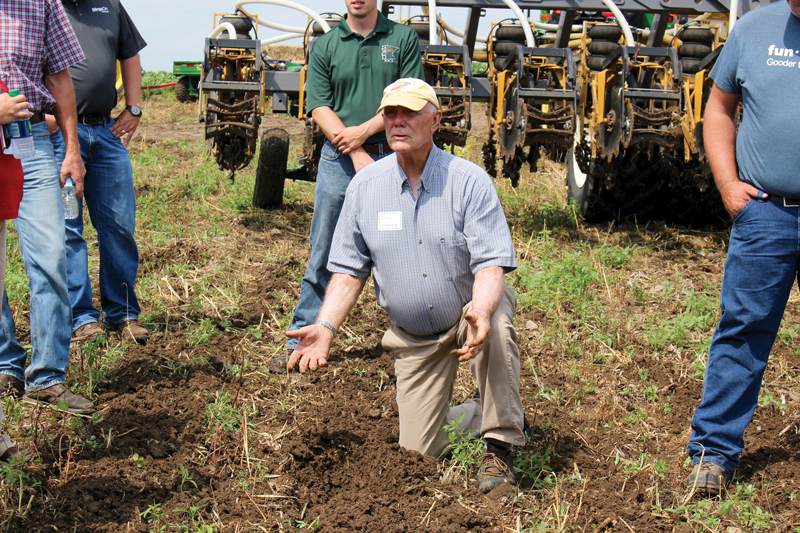
After moving to the farm in 1976, I had this grand vision of being an organic farmer. Organic production was presented as the only way to go, because it was so good for the environment. I bought into that. But after farming organically for 2 years, which requires doing a lot of tillage, I was seeing some soil degradation. So I began to look for something better.
I got a phone call from a colleague of mine one day, and he said, ‘You’ve got to come and see this thing.’ It was a strip-till machine. When I heard strip-till — you could have said, ‘vegetables on Mars,’ and it would have meant the same to me. So I went to this place just south of Northfield. He was a hog farmer, a grain farmer and a metal magician. He’d built this thing that would till only a small strip throughout the field.
He farmed in some pretty hilly areas, so he needed to till this way to avoid erosion. I loved what it did, creating tilled zones that were deep, yet retaining most of the crop residue. He didn’t even have to broadcast fertilizer and work it in, because the fertilizer was placed by the delivery system built into the machine. That first machine was a little on the crude side: it had markers instead of a GPS, which was very strange. But when I looked at it, I thought, ‘Wow. Somebody finally hit the dinner plate.’
A year or so later, I got a call from Mark Bauer, the inventor of the Soil Warrior. He said, ‘I’ve got the beta model built,’ and I came. I looked at it and said, ‘Wow, Mark, there is a lot of steel in this machine.’ He said, ‘Yes, I hate to flipping fix stuff.’ In over ten years of service my machine has not been touched with a welder. The only problem was a bolt that fell out.
The 2019 Strip-Till Innovator program is supported by Montag Mfg.

I began to try out the strip-till machine and really liked it. I thought it made good sense. I went in whole-hog. People ask me, ‘Gosh, how can you do that?’ I say to them, ‘Well, it’s kind of like courting your wife. Eventually, she had to decide, or you had to decide to commit.’
Embrace ‘Worm Snot’
I find that in these times of financial stress for farmers — commodity prices have really hit the tank — it’s nice to be able to say, ‘Yes, I’m using six-tenths of a gallon of fuel to prepare the ground and apply fertilizer.’ I use that same amount of fuel per-acre to pull the planter. So by not doing heavy tillage and destroying the soil, there’s tremendous fuel savings, which is good for the environment and my pocketbook.
The nice, well-drained topography on my farm caused my soil to migrate downhill when I was doing invasive tillage, which also destroys organic matter. I’d worked with students at St. Olaf College to experiment with what happens when we put stuff in the soil, and watch it degrade.
We buried apples, dead snakes, all kinds of stuff, and then come back a few months later to check out what was going on. We found that nature is a powerful decomposer, and that led us to understand that we’re taking carbon, in the form of the residue, and decomposing it. That releases CO2 into the atmosphere, rather than keeping it in or on the soil, for enhanced organic matter and better erosion protection. So, over the years, I have watched my soil become more and more stable.
“There’s really nothing that pisses an angleworm off more than burying its food 8-inches deep…” — David Legvold
The scientific aspect was even brought home to a greater degree when some Carleton College students came out with their soil respiration equipment and put their little “sniffers,” as I call them, on the ground. They were able to quantify the amount of CO2 coming off of a piece of ground that I’d just recently tilled compared to ground that was left no-till. Very little CO2 emission on no-till ground, but in heavily tilled areas, it was pretty amazing.
If we leave the soil alone, there are processes that work to hold the soil together nicely, developing soil aggregation. So I like to see my soil crumble into pieces, like a piece of chocolate cake, instead of like a handful of chocolate cake mix, which is pretty powdery and will blow or wash away. Soil aggregation is made up of sugars that a plant exudes, which hold the soil together. I call it “worm snot.” It’s what holds the soil together.
Seeing is Believing
A really scary but eye-opening situation occurred when a landowner and I agreed that a field needed tile. The soil was not very productive — it had been compacted many times because it was wet. I was not comfortable continuing to treat the soil that way. So, we agreed to tile the 20-acre field. After the tiling was done, we needed to straighten out all the tile runs. My son took our only tillage tool and tilled the soil — I mean he tilled it, and tilled it, and tilled it.
We have data from that field that’s several years old, from the students doing their soil quality research. Two young women came in and sampled that field, and they took over 200 soil samples after the significant tillage event; so we know that their science is valid. They found that one significant tillage event reduced the soil’s organic matter by 0.5% in one year. That was as disturbing as it was eye opening.

Another example occurred in the summer of 2018, with a St. Olaf research colleague who was doing an experiment on infiltration. She took her infiltrometer — a coffee can with both ends cut out of it — snuggled it into the strip-till soil and poured in 300 milliliters of water. It took 18 seconds for that water to disappear. We went to another field that had significant, invasive, heavy tillage, and employed the same technique and the same amount of water; it took 4 minutes and 40 some seconds for 300 milliliters of water to infiltrate.
When I listen to farmers get excited about a 1½-inch rain, my question is, ‘How much did your field capture, and how much ran off?’ I think I can say with good scientific basis that I capture most of my rainfall.
Keep Earthworms Happy
When I was doing full-width tillage, I would broadcast fertilizer on the top of the soil. With the field cultivator, I would stir that stuff in about 2 inches deep. That was my planting zone. I’d put my seeds in, and they would germinate in that top 1-1½ inches of soil. Their roots would go down, and whoa — they would reach the untilled layer. In some cases, that could be like a cement sidewalk.
With the strip-till machine, I till a zone that is about 6 inches wide and 9 inches deep. All of the fertilizer blown in that zone is mixed right into the soil. So, when I plant the seed at the same depth as before, that corn plant has lots of room to grow in a fertilizer-rich environment, while it’s sprouting its leaves. So it just made sense to me.

KNOW YOUR SOIL. Extensive on-farm research, and educational efforts to share lessons about soil health, increasing production and farm efficiency have long been staples of David Legvold’s strip-till system.
Why should I capture my seeds in a 2-inch zone and then have them run into a hard layer, when I could prepare the most hospitable zone possible (we call this zone-tillage), to plant the seeds? The physics, the chemistry, the agronomic efficacy — it’s right there. I didn’t have to study it very long to figure that out.
I don’t apply all the fertilizer in one shot. With the strip-till rig, I apply nitrogen (N), phosphorous (P), potash, some sulfur and a little squirt of zinc. I only apply about 40 pounds of N, because I don’t want the zone to get too hot for the seeds. At about V5-V6 stage for corn, I come back and sidedress, using a disc inserter with a squirt gun behind it that squirts the liquid 28% right into the earth.
“It’s nice to be able to say I’m only using six-tenths of a gallon of fuel to prepare the ground and apply fertilizer…”
That’s enhanced my fertilizer efficiency well. Many people still apply 300 pounds of anhydrous in the fall, and hope that there might be 200 pounds left in the spring. My question is, where has that extra 100 pounds of N gone? Perhaps it’s been volatilized in the air, or in some of the lighter soils has become part of the groundwater.
The banding of fertilizer and incorporating it into a deep zone allows you to reduce the amount that you use. Right now I’m working with a PhD student from the University of Minnesota who’s studying mycorrhizal fungi. Mycorrhizal fungi do not take kindly to being tilled-up every year. If left along, it will digest, and make available, the P from the soil.
The mycorrhizal fungi form a symbiotic relationship with the roots of your commodity crop. So why apply 75 pounds of P when you can apply one-third less and let nature do its work? I find that by not disturbing the soil a great deal, I can use nature’s processes to bring forward the nutrients that I need.
Embracing Experiments
With N, spoon-feeding the crop as you go is the right move, so I built my own sidedress rig using virtually all off-the-shelf parts. It’s about a 3-bushel hopper that fits into a receiver hitch welded to the frame of the applicator bar, and is controlled electrically from the tractor cab.

BUILT TO LAST. David Legvold has always been willing to experiment with equipment setups and built his own sidedress rig, which also serves as a cover crop seeder using virtually all off-the-shelf parts. The 3-bushel hopper fits into the receiver hitch and has an electrically-powered spinner on the back.
So my rig is comprised of two off-the-shelf hoppers and spinners from a local tool store, mounted on the back of a 28% bar. Consider pickup trucks plowing snow in the winter with a salt hopper on the back of the truck. My son, Mark, adapted the salt spinner to distribute cover crop seed. They’re electrically powered, so we can turn them on and off. We use it to apply N and broadcast cover crop seed. It’s a slick deal.
Check out the the 3-part 2019 Strip-Till Farmer's Strip-Till Innovator video series is sponsored by Montag Mfg.
Montag Mfg. manufactures and sells complete fertilizer systems, dry fertilizer metering systems, liquid fertilizer systems and auto-steer carts.
I bring that machine out when the corn is about 6-8 inches high. I want to apply the N just as the corn is beginning to get really thirsty for that product. I’ve done a fair amount of research on different rates of N and assessed the return. We’ve found that if you apply 300 pounds of N in-season, that’s way too much.
That tells a very interesting tale on our farm, in that the stock nitrate level on corn that’s over-applied with N is pretty high, and it doesn’t need to be. The yield tends to curve off. It’s not the more we apply, the more yield we get. At a certain point, we’re just wasting money.
We’ve also made sure we incorporate all of the liquid N. For a couple of years in a row, we just dribbled the same amount of N on the surface of the soil, and found that a zero rate was just as effective as the dribbled rate of 100 pounds of N per acre. I learned that it’s good to get that nitrate into the soil, but more N is not better.
Side-by-side, strip-till is just as productive as conventional tillage, broadcast fertilizer tilled in and planted in a nice 2- or 2½-inch-deep seedbed. With conventional tillage, there’s a lot of motion with basically no yield benefit. We’ve also found that there is significant soil health benefit with strip-till. I like to feed my worms, my critters and my stuff in the soil; the residue on the top is very important.
There’s really nothing that pisses an angleworm off more than burying its food 8-inches deep. You don’t want to do that.






